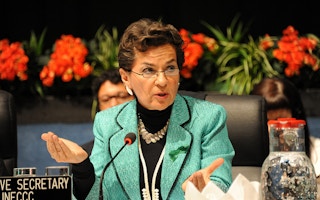Christiana Figueres, the Costa Rican diplomat who played an instrumental role in brokering the Paris climate agreement, heralded the role of cities in a campaign announced Monday to urge that action will have to take place by the end of this decade to make good on the landmark accord.
A little over a year has passed since Figueres, then the executive director of the United Nations Framework Convention on Climate Change, successfully brought 197 countries to the table in the French capital.
Now, with the agreement ratified and the clock ticking to the first major milestone for the binding deal, Figueres has pivoted to a new role at the helm of the campaign, Mission 2020.
“What has been missing since Paris is a near-term focal point for action, which is why we have brought together some of the best minds on the subject to collectively demonstrate that the arc of transformation to a fossil-free energy system is possible,” Figueres said Monday.
[See: Explainer: What is the Paris Agreement on climate change and what does it mean for cities?]
For Figueres, that “turning point” must take place by 2020, at which point global emissions need to begin to decline, a time frame urged by scientific consensus.
“
We must be determined, and stubbornly foster innovative thinking and radical collaboration so that we reach the junction on time, together.
Christiana Figueres, former executive secretary, United Nations Framework Convention on Climate Change
The focus of the new initiative will be to amplify this message to policymakers worldwide — and to highlight feasible routes to making that happen.
Under the terms of the Paris Agreement, countries are expected to “ratchet up” their emissions reduction plans every five years, starting in 2020.
That’s because the plans presented in Paris ahead of the December 2015 climate conference would not on their own keep global mean temperature rise below 2 degrees Celsius by 2100.
Scientific consensus agrees that 2 degrees C — and ideally 1.5 degrees — is the upper limit to avoid the worst effects of global climate change, such as sea-level rise, widespread drought and extreme weather events.
[See: Cities to receive new, ongoing focus in official climate research]
Consequently, advocates for action on climate change, including Figueres, see the period between now and 2020 — the next major milestone on the official calendar — as “bending the arc” toward a planet where economic growth and reduced greenhouse-gas emissions are not mutually exclusive.
‘Business as urgent’
Mission 2020 calls that year a turning point for demonstrable progress in six broad categories: energy, infrastructure, transportation, land use, industry and finance.
Two of those goals have explicitly urban dimensions. Mission 2020 describes its goals for infrastructure as action taken by cities and local governments “to fully decarbonise buildings and infrastructure by 2050”.
As for transport, the campaign calls for zero-emissions vehicles to be “the preferred form of all mobility in the world’s major cities and transport routes”.
[See: Make no mistake, momentum is growing to ‘localize’ climate finance]
In a new report, Mission 2020 spells out some key metrics behind these goals. On buildings and infrastructure, these aims include, by 2020, investing at least USD 300 billion each year to support “infrastructure decarbonization”, beyond usual spending.
They also include construction all new buildings according to zero or near-zero energy standards, as well as upgrading at least 3 per cent of existing buildings each year to the same standards.
In transport, the group will be pushing to hit an even more complex series of marks by the start of the next decade: electric vehicles accounting for up more than 15 per cent of new car sales globally, public transport doubling its market share, the aviation sector reducing its emissions by 20 per cent, increasing efficiency standards for heavy-duty vehicles by 20 per cent, and moves toward eliminating emissions from the shipping sector.
Speaking this week at Google UK’s headquarters in London, Figueres said, “The way that we live, work and move in cities needs to be decarbonized.”
She lauded the C40 Cities Climate Leadership Group for likewise adopting the near-term milestone in its recent Deadline 2020 report, which claims a USD 15 billion investment portfolio in climate-friendly urban infrastructure projects.
[See: Initiative aims to make more green infrastructure projects ‘bankable’]
In addition, Figueres singled out a new European Union regulation that all new buildings must be zero-emission by 2020. And she heaped praise on China for “astonishing us” with ever-increasing building efficiency and the promotion of “sponge cities” that soak in rainwater.
Such actions are crucial, in Figueres’s mind, not only to set the right path by 2020 but also to deliver on the Sustainable Development Goals a decade later — and ultimately, a “net zero” world by 2050. (Like the Paris Agreement, the SDGs were finalised in late 2015 and went into implementation last year.)
“Whether we can achieve the 2020 turning point will depend on our ambition, our will-power in staying the course and on how we define the acronym BAU. We are no longer in a world of business as usual; we are now in business as urgent,” she wrote in an editorial published this week.
“We must be determined, and stubbornly foster innovative thinking and radical collaboration so that we reach the junction on time, together.”
Carey L. Biron contributed to this report.
This story was published with permission from Citiscope, a nonprofit news outlet that covers innovations in cities around the world. More at Citiscope.org.










